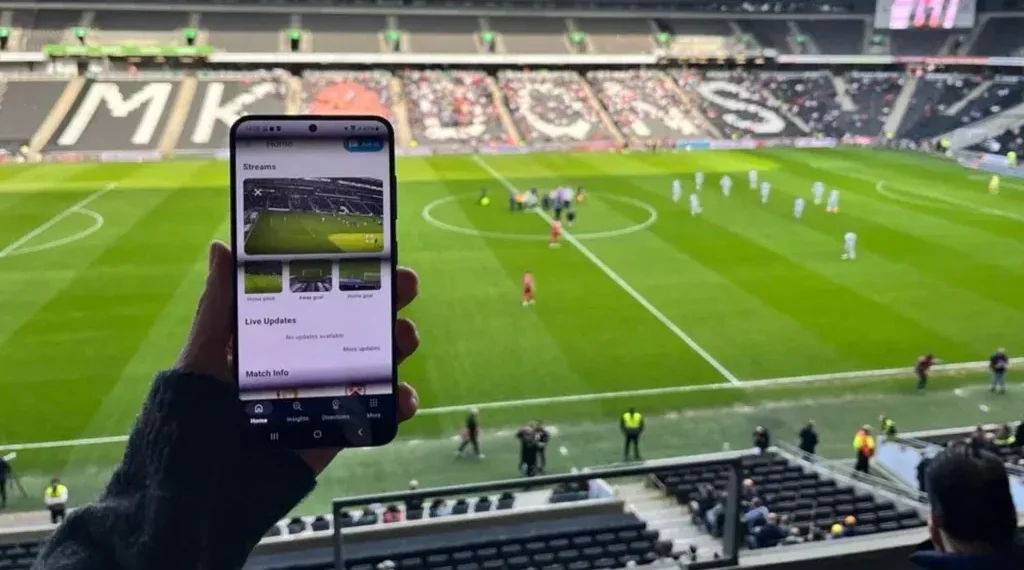A new UK-developed technology combining artificial intelligence and advanced 5G connectivity is being hailed as a potential turning point for live sports audiences. Researchers say the system, successfully tested at a stadium in Milton Keynes, could eliminate long-standing mobile signal problems and create a far more interactive match-day experience for fans.
A New Era of Connectivity for Stadium Audiences
The introduction of stadium fan technology marks what researchers describe as a major leap in the way spectators engage with live sport. For years, fans at large venues have complained about weak mobile signals, slow data speeds, and an inability to share moments online in real time. With tens of thousands of people trying to connect simultaneously, traditional networks often buckle under pressure.
Scientists from the University of Bristol, working alongside AI specialists Madevo and network-infrastructure firm Weaver Labs, believe they have developed a solution capable of reshaping that reality. Their system blends AI, 5G broadcasting and flexible network management tools into a single platform designed specifically for high-density venues.
The concept was trialled at a stadium in Milton Keynes, where researchers tested real-time streaming, interactive features, and live data feeds directly to supporters’ mobile devices. They say the results exceeded expectations, offering fans stable connectivity even at moments of peak online activity.
Researchers Say Innovation Could Redefine the Match-Day Experience
Professor Dimitra Simeonidou of the University of Bristol described the system as a significant milestone in how people may soon experience large-scale events. Speaking after the trial, she said the team was “excited to see how these technologies can dramatically reshape how we experience live events,” pointing to the platform’s potential across sport, music, and entertainment.
The university has said that fans were able to stream four high-quality live video feeds directly to their phones at the tap of a screen. This included multi-angle views of the pitch, player statistics updated in real time, and exclusive behind-the-scenes content that would normally be inaccessible during live matches.
Such features, researchers argue, could bring spectators closer to the game, offering a layer of insight that television viewers have long enjoyed but stadium visitors rarely receive. By combining on-site broadcasting, edge computing and network automation, the system aims to make those features available without compromising basic connectivity.
AI-Enhanced Tools Designed to Tackle Long-Standing Problems
Large stadiums have traditionally been difficult environments for mobile networks. High user density, concrete structures and simultaneous activity create signal congestion that even modern 4G and basic 5G networks struggle to handle. According to the University of Bristol, these limitations have been a persistent frustration for supporters and a challenge for clubs seeking to modernise match-day entertainment.
By incorporating AI into network orchestration, the new platform can adjust bandwidth, allocate capacity dynamically, and prioritise high-demand services—such as video feeds or app-based navigation—depending on crowd behaviour. Researchers believe this adaptability could become a model for the next generation of smart stadiums.
A university spokesperson said the system could be “a game changer” for football clubs seeking to enhance the match-day experience while also collecting operational insights. When combined with venue apps, the technology could support everything from crowd-flow management to concession-stand efficiency and emergency communication.
Faster Access to Statistics, Behind-the-Scenes Footage and Real-Time Queues
Beyond video feeds, the platform offers several features designed to improve the overall fan journey. During trials, fans could access instant player statistics, tactical overlays and in-game metrics often reserved for broadcasters. The system also includes tools for live queue monitoring, giving supporters information on waiting times for food, merchandise or restrooms.
These types of enhanced services are increasingly expected as sports organisations attempt to modernise older stadiums and align with global trends in fan engagement. In U.S. arenas, for example, teams have spent the past decade experimenting with digital dashboards, high-density Wi-Fi and app-based services. European stadiums have similarly been upgrading connectivity, but challenges persist in older venues where modern infrastructure can be difficult to retrofit.
5G Broadcast Seen as Cost-Effective Alternative for Packed Venues
Professor Simeonidou, who leads the Smart Internet Lab at Bristol, noted that the trial represented a milestone for the research facility as it reached its 10-year anniversary. She said the 5G broadcast capabilities demonstrated during testing offered a “cost-effective alternative to traditional cellular solutions,” particularly in packed stadium environments where conventional networks are often “unreliable during peak usage.”
Broadcast-style 5G, unlike typical mobile connections, allows signals to be distributed to large groups without individual capacity constraints. When combined with AI traffic management, this approach can help maintain stability even when demand spikes unexpectedly, such as during goals, penalties or video assistant referee (VAR) decisions.
The researchers expect that continued refinement could lead to more widespread adoption across UK sports venues. They also believe the system could be applied to concerts, festivals and any large gathering where crowds require stable connectivity.
Towards Fully Smart-Enabled Stadiums
If widely adopted, the technology could support broader ambitions to create fully “smart-enabled” stadiums. This would involve integrating smart ticketing, augmented-reality features, live polls, merchandise promotions, and operational data into unified digital platforms. German, U.S. and Korean stadiums have already experimented with some of these tools, though reliability still varies.
British academics say the trial in Milton Keynes demonstrates that a UK-developed system can meet or exceed performance benchmarks achieved abroad. The project partners argue that such technology could help clubs modernise without expensive overhauls, making it attractive for mid-sized venues as well as Premier League grounds.
While further tests are expected, stakeholders appear confident that the innovation will continue to develop. For now, the Milton Keynes trial serves as an early example of how stadium experiences may shift in the years ahead—moving from traditional live viewing to a hybrid model where digital enhancements complement the spectacle on the pitch.
This article was rewritten by JournosNews.com based on verified reporting from trusted sources. The content has been independently reviewed, fact-checked, and edited for accuracy, neutrality, tone, and global readability in accordance with Google News and AdSense standards.
All opinions, quotes, or statements from contributors, experts, or sourced organizations do not necessarily reflect the views of JournosNews.com. JournosNews.com maintains full editorial independence from any external funders, sponsors, or organizations.
Stay informed with JournosNews.com — your trusted source for verified global reporting and in-depth analysis. Follow us on Google News, BlueSky, and X for real-time updates.











